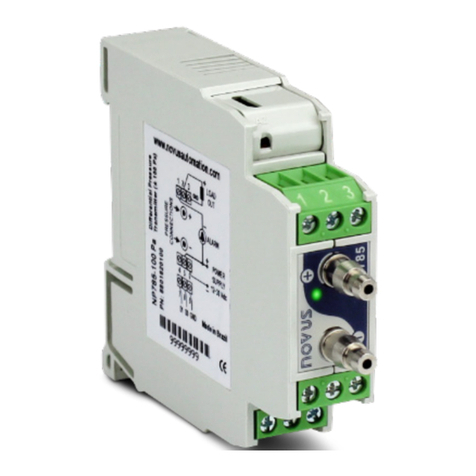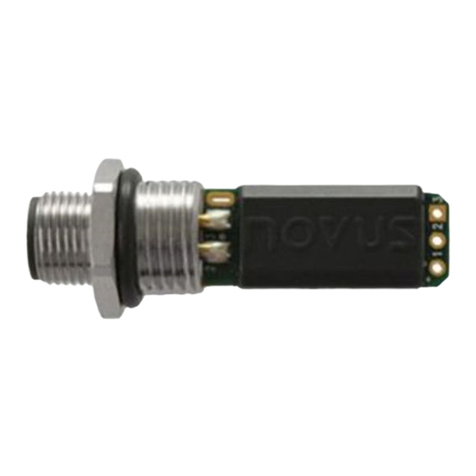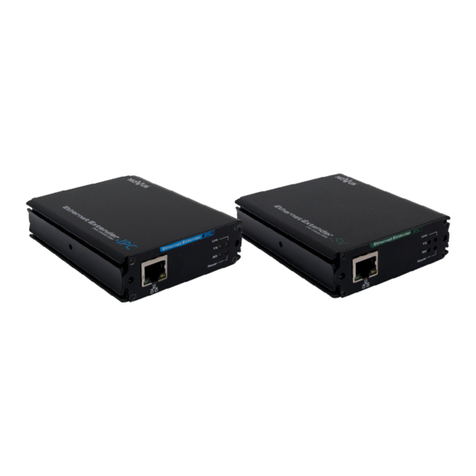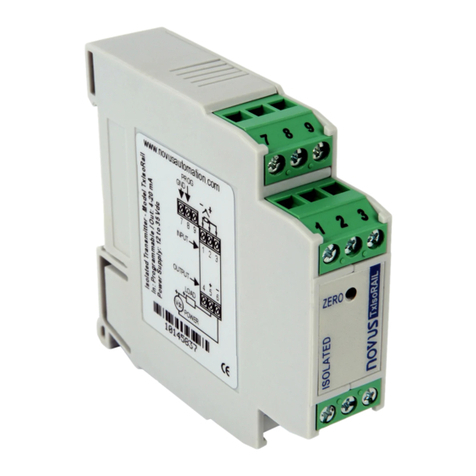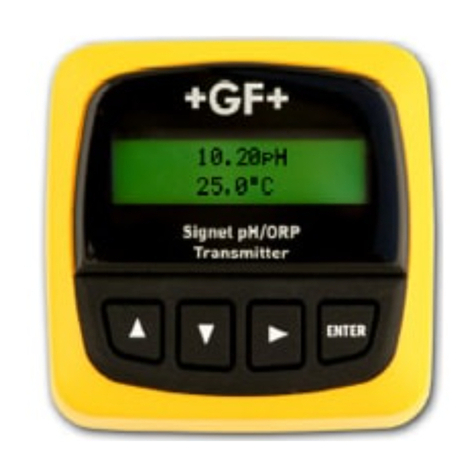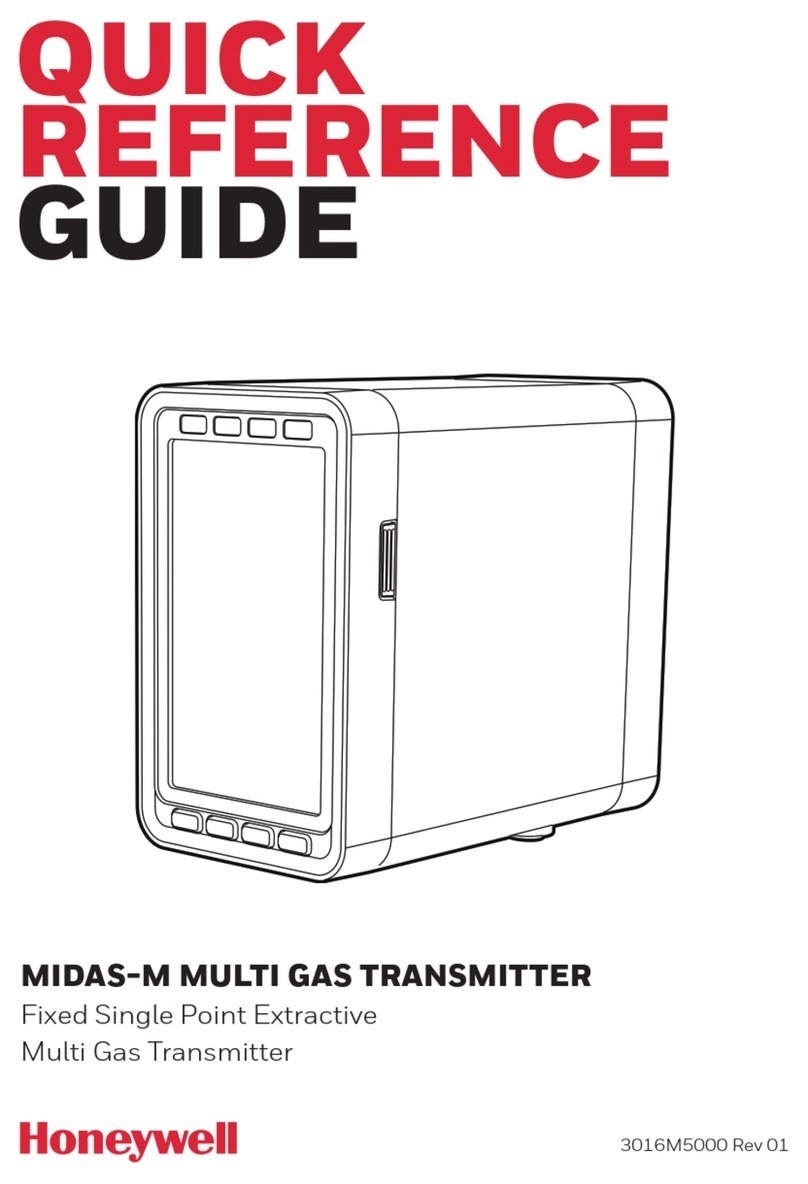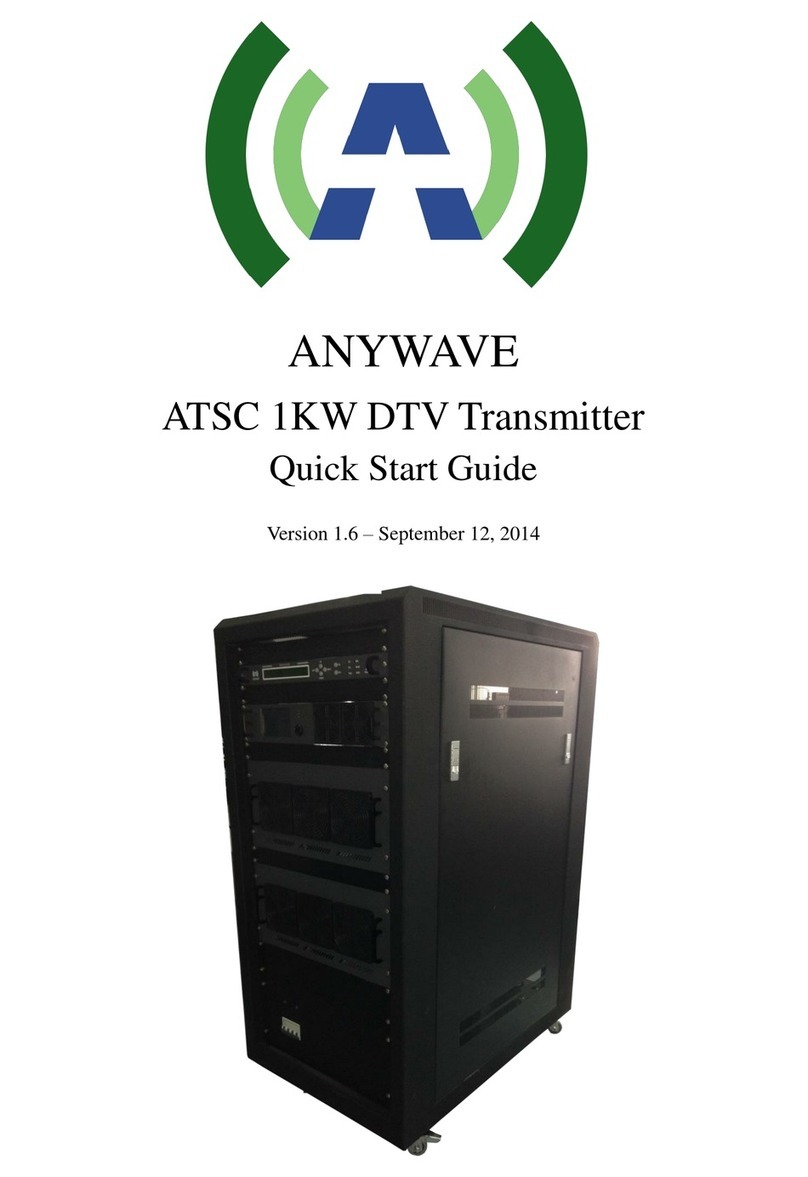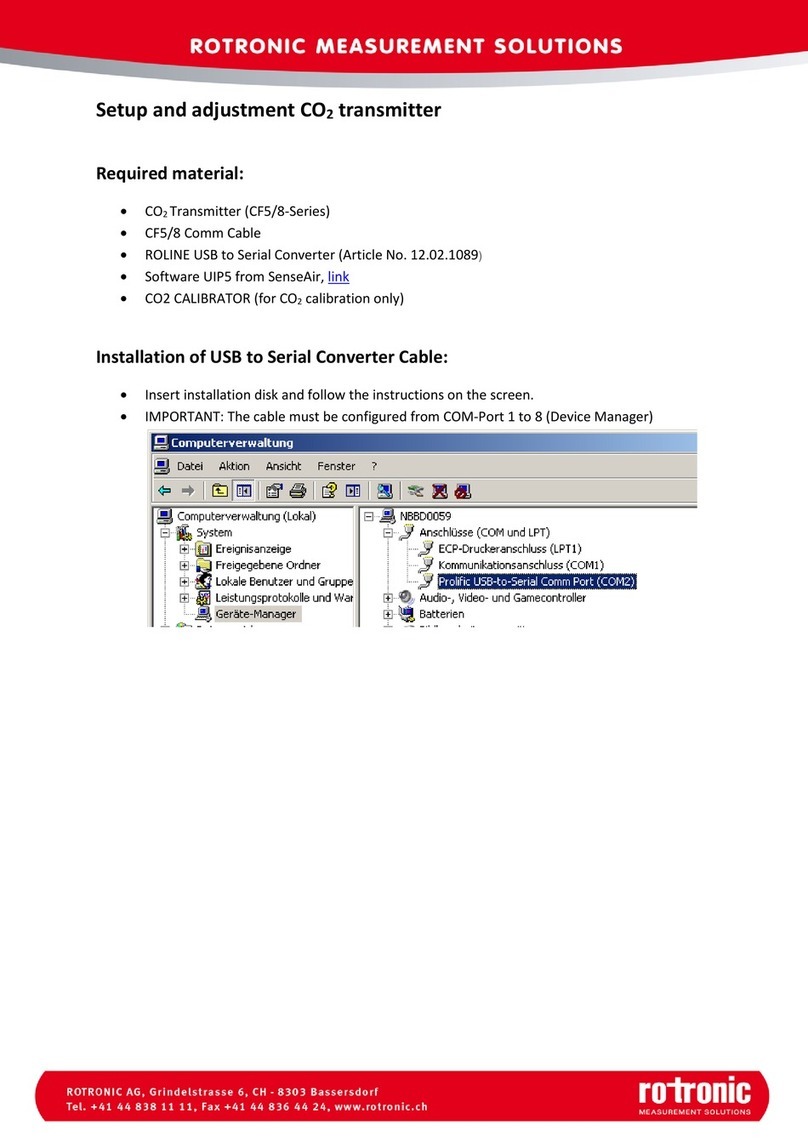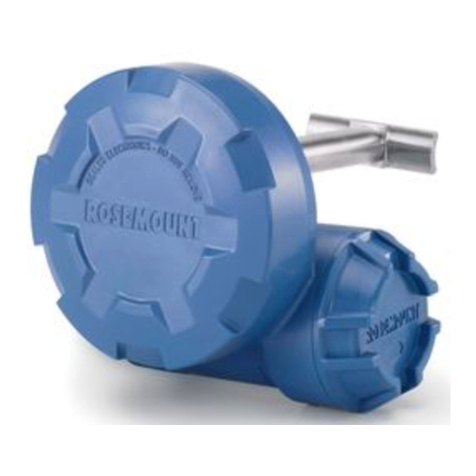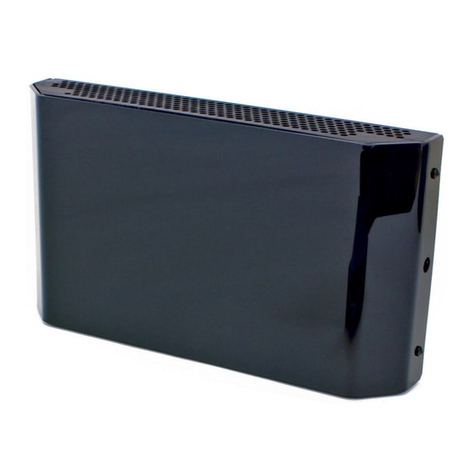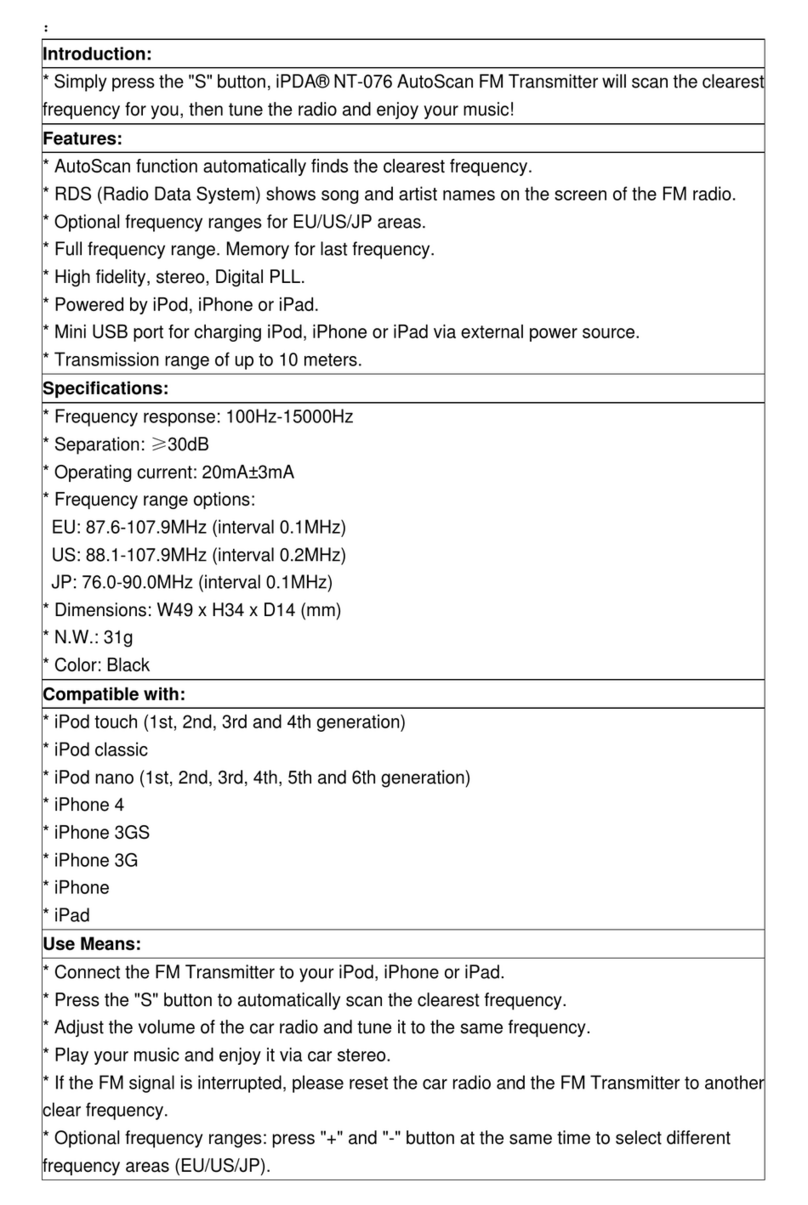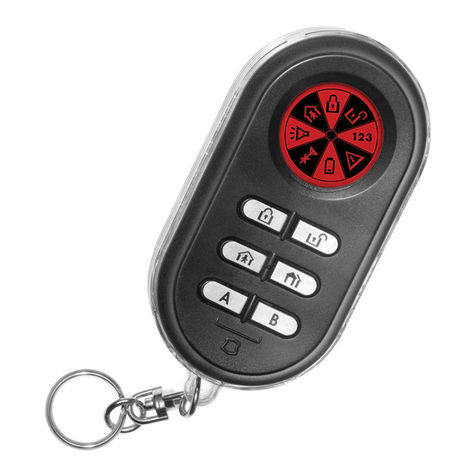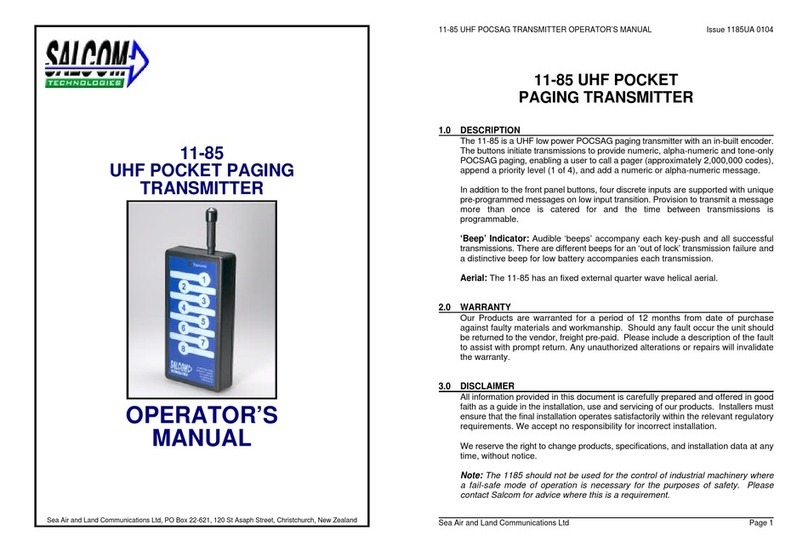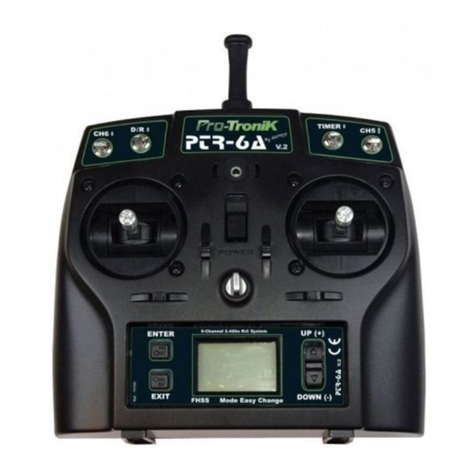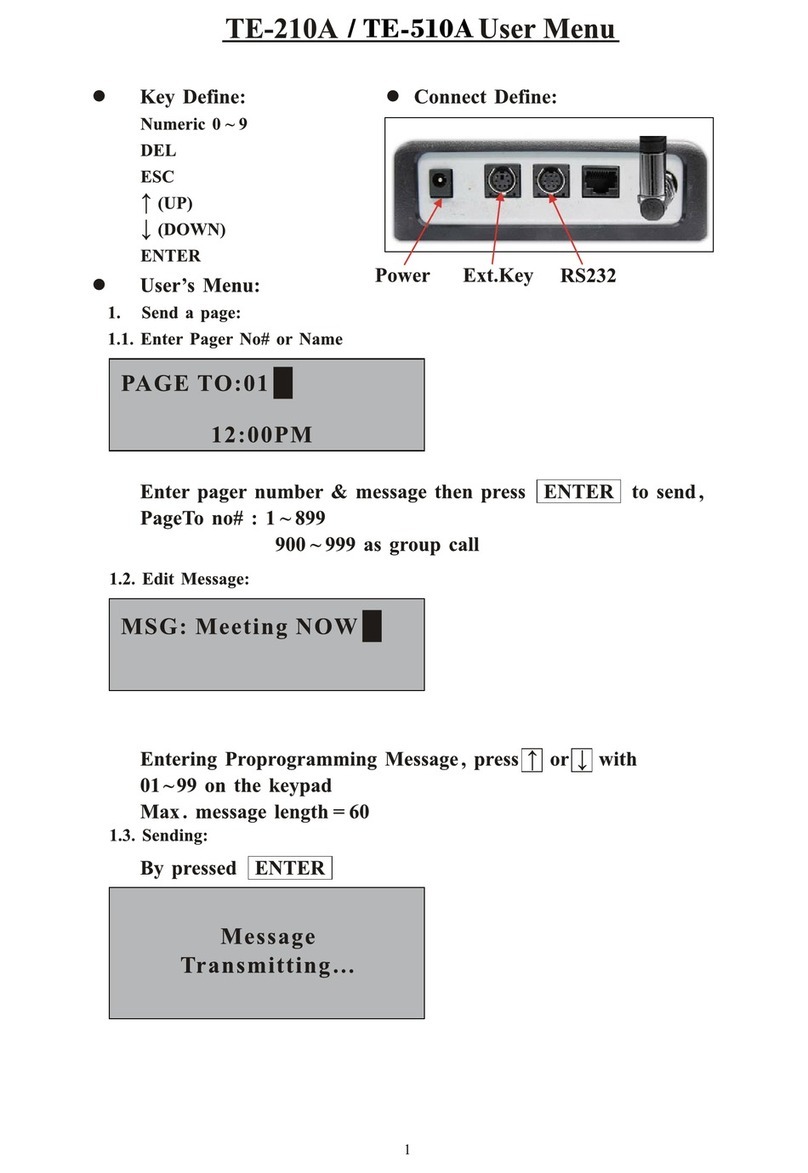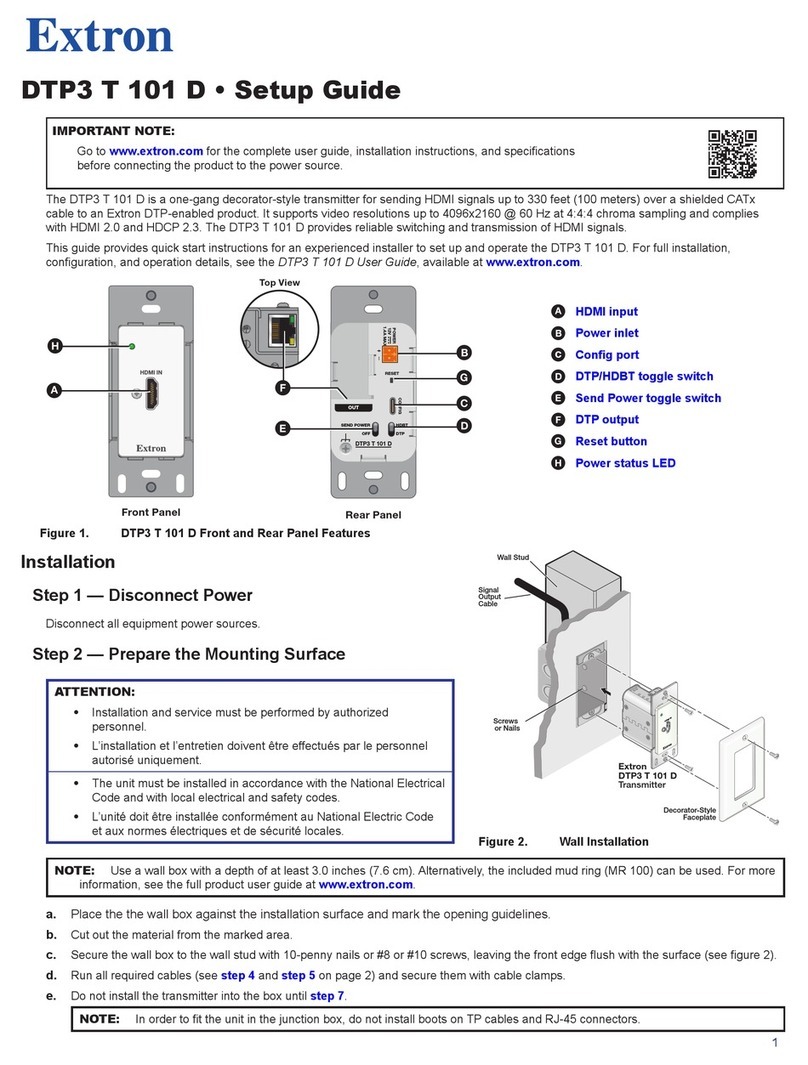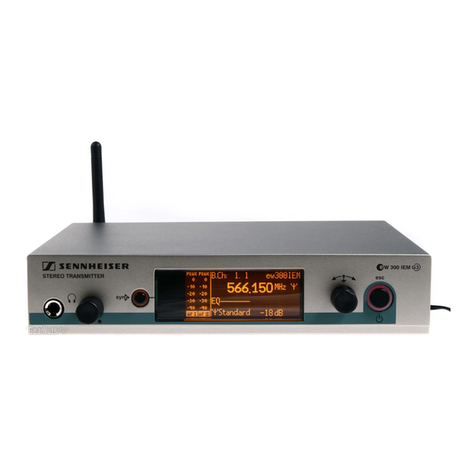Novus TxIsoRail User manual

NOVUS AUTOMATION 1/5
TxIsoRail
ISOLATED TRANSMITTER
– USER GUIDE − V1.0x
1. SPECIFICATIONS
Sensor input: User defined. The supported sensors are listed in
Table 1, along with their maximum ranges.
Thermocouples: Types J, K, R, S, T, N, E, and B, according to
IEC 60584 (ITS-90). Impedance >> 1 MΩ
Pt100: 3-wire connection, Excitation: 180 µA, α= 0.00385,
according to IEC 60751 (ITS-90).
For 2-wire Pt100, tie terminals 2 and 3 together.
Voltage: 0 to 50 mVdc, 0 to 10 Vdc. Impedance >> 1 MΩ.
Current: 0 to 20 mA, 4 to 20 mA. Impedance 15.0 Ω(+ 1.9 Vdc).
SENSOR TYPE RANGE
MINIMUM
MEASUREMENT
SPAN
Thermocouple K -150 to 1370 °C / -238 to 2498 °F 100 °C / 212 °F
Thermocouple J -100 to 760 °C / -148 to 1400 °F 100 °C / 212 °F
Thermocouple R -50 to 1760 °C / -58 to 3200 °F 400 °C / 752 °F
Thermocouple S -50 to 1760 °C / -58 to 3200 °F 400 °C / 752 °F
Thermocouple T -160 to 400 °C / -256 to 752 °F 100 °C / 212 °F
Thermocouple N -270 to 1300 °C / -454 to 2372 °F 100 °C / 212 °F
Thermocouple E -90 to 720 °C / -130 to 1328 °F 100 °C / 212 °F
Thermocouple B 500 to 1820 °C / 932 to 3308 °F 400 °C / 752 °F
Pt100 -200 to 600 °C / -328 to 1112 °F 40 °C / 104 °F
Voltage
0 to 50 mV 5 mV
0 to 10 V * 1 V
Current
0 to 20 mA 2 mA
4 to 20 mA 2 mA
Table 1 –Transmitter input sensors
* Note: 0-10 Vdc input type requires an internal jumper switching.
Response time:< 500 ms
Electrical isolation: 1000 V for 1 minute between input and output.
Maximum load (RL): RL (max.)= (Vdc – 12) / 0.02 [Ω]
Where: Vdc = Power supply voltage
Operating temperature: -40 to 85 °C / -40 to 185 °F
Humidity: 0 to 90 % UR
Electromagnetic compatibility: EN 50081-2, EN 50082-2
Internal protection against polarity inversion.
Cold Junction compensation for thermocouples.
Certifications: CE, UKCA.
1.1 4-20 mA MODEL
Output: 4-20 mA or 20-4 mA current, 2-wire type; linear to input
signal.
Output resolution: 0.001 mA (14 bits)
Total accuracy: 0.30 % of maximum range for thermocouples, ±1
°C;
0.20 % of maximum range for Pt100, voltage, and
current.
Power supply: 12 to 35 Vdc, voltage applied to the transmitter.
1.2 0-10 VDC MODEL
Output: Voltage 0 to 10 Vdc or 10 to 0 Vdc; linear to input signal.
Output resolution: 0.0006 V (14 bits)
Total accuracy: 0.25 % of maximum range for thermocouples, ±1
°C;
0.15 % of maximum range for Pt100, voltage, and
current.
Power supply: 18 to 30 Vdc, voltage applied to the transmitter.
2. CONFIGURATION
When the transmitter is used with the factory setting, no further
action is required, and the transmitter is ready to be installed.
When it is necessary to change the configuration of the equipment,
you should use SigNow software, TxConfig software, or SigNow
app.
To configure the equipment through any of the software, you must
connect the TxConfig Configuration Interface (purchased from the
manufacturer or its authorized representatives) to the USB port of
the computer used and run the selected software, as shown in
Figure 1:
Figure 1 –TxConfig Interface USB connections
To configure the device via SigNow app, you need to use an OTG
cable with the TxConfig Configuration Interface and proceed with
the recognition process (see SMARTPHONE CONNECTIONS
chapter).
On NOVUS website, you can download the configuration software
for free. To install it, simply run the file SigNowSetup.exe or the file
TxConfigSetup.exe and follow the instructions in the installer.
The SigNow setup application can be downloaded for free from the
Google Play Store or the App Store.

NOVUS AUTOMATION 2/5
2.1 SOFTWARE AND APP
2.1.1 SIGNOW SOFTWARE
When running the SigNow software and connecting to the device,
the following screen will appear:
Figure 2 –SigNow configuration screen
The bottom part of the screen displays information about the model,
serial number, and firmware version.
The configuration screen is divided into 4 sections: General,
Settings, Diagnostics and Firmware Update.
In the General (see above) and Settings screens, you can configure
the device by setting values and information for the following
parameters:
1. Sensor Type: Allows you to select the sensor to be used. See
Table 1.
2. Temperature Unit: Allows you to select the temperature unit to
be used.
3. Lower Limit: Allows you to define the minimum desired
temperature for the configured output type.
4. Upper Limit: Allows you to define the maximum desired
temperature for the configured output type.
5. Sensor Failure: Allows you to establish the output behavior
when the transmitter indicates a failure:
Minimum: Output current goes to < 3.6 mA (down-scale),
typically used for refrigeration.
Maximum: Output current goes to > 22.0 mA (up-scale),
typically used for heating.
6. Network Frequency: Allows you the network frequency to be
used.
7. Output Type: Displays the output type of the equipment, which
will change according to the model (TxIsoRail 4-20 mA or
TxIsoRail 0-10 Vdc).
8. Zero Correction: Allows you to correct small deviations
presented in the transmitter output, such as when changing a
sensor.
In the SigNow manual, available on NOVUS website, you can get
more specific information about the buttons and the process of
diagnostics and firmware update.
2.1.2 TXCONFIG SOFTWARE
When running the TxConfig software and connecting to the device,
the following screen will appear:
Figure 3 –TxConfig software main screen
The fields in the screen mean:
1. Input Sensor: Allows you to select the sensor to be used. See
Table 1.
2. Measuring Range: Allows you to define the measurement range
of the transmitter, showing a Lower Limit value and an Upper
Limit value.
When configuring the Lower Limit with a value higher than the
Upper Limit, the output current operates from 20 to 4 mA.
The chosen values cannot exceed the Sensor Range shown in
this same field. It is not possible to set the span narrower than
the Minimum Range value shown below in this same field. See
Table 1.
3. Line Noise Rejection: Allows you to filter the measurements
made by the transmitter, eliminating interferences from the
electrical network that feeds the process.
4. Sensor Failure: Allows you to establish the output behavior
(upscale or downscale) when the transmitter indicates a failure.
5. Zero Correction: Allows you to correct small deviations
presented in the transmitter output, such as when changing a
sensor.
6. Device Information: This field shows data that identifies the
transmitter, including the model (TxIsoRail 4-20 mA or
TxIsoRail 0-10 Vdc). This information should be sent to the
manufacturer in an eventual request for technical assistance.
7. Apply: Allows you to send a new configuration to the transmitter.
8. Read Device: Allows you to read the configuration present in the
connected transmitter. The screen will display the current
configuration, which can be changed.

NOVUS AUTOMATION 3/5
2.1.3 SIGNOW APP
When using an OTG cable and the TxConfig Configuration
Interface to connect the equipment to your smartphone and run the
SigNow app (see SMARTPHONE CONNECTIONS chapter), you
must first enable the use of TxConfig.
The interface will act as an intermediary for the connection:
Figure 4 –Using TxConfig
After that, the app will recognize TxConfig and show the main
screen:
Figure 5 –Main screen
To configure the equipment, just click the Configuration button.
Then, the app will show the main screen of the TxIsoRail
Configuration section:
Figure 6 –Information screen
This screen shows information about the equipment, such as name,
serial number, and firmware version.
When you open the Config section, you can configure the
parameters displayed in the SIGNOW SOFTWARE section.
In the SigNow manual, available on NOVUS website, you can find
more information about the buttons and the diagnostic process.
2.2 FACTORY SETTINGS
If the specific configuration is not defined in the purchase order, the
following configuration will be adopted:
Pt100 input, 0 to 100 °C (32 to 212 °F).
60 Hz filtering and upscale (20 mA) output for sensor fail.
2.3 POWER SUPPLY
During configuration, the transmitter needs to be electrically
powered. The TxConfig Interface itself provides the power supply,
but this depends on the computer used.
To ensure constant communication between the transmitter and the
computer, an external power supply must be provided.
It is also possible to configure the transmitter by keeping it
connected to the process, using energy from the very source that
feeds this process (loop). See Figure 7.
Figure 7 –TxConfig Interface USB connections – Loop powered
The TxConfig Interface has a complex electronic
circuit. Do not use any other interface or cable
connection to USB.
This will damage the
product and this damage is
not covered under warranty.
3. SMARTPHONE CONNECTIONS
Smartphones with On the Go (OTG) technology can be directly
connected to the device via the Micro-USB input. Using the
TxConfig Configuration Interface, it is possible to recognize and
configure a TxIsoRail by running the SigNow app.
To do this, as shown in Figure 8, you need to observe how to
connect the OTG cable to the equipment:
Figure 8 –OTG Cable

NOVUS AUTOMATION 4/5
Incorrect positioning of the cable tip can cause
the equipment not to be recognized by the app.
4. MECHANICAL INSTALLATION
The transmitter is designed to be installed on a 35 mm DIN rail.
Figure 9 –Transmitter dimensions
5. ELECTRICAL CONNECTIONS
Figure below shows the transmitter connections to the sensor and
power supply. Terminals 1, 2, and 3 are used for sensor input.
When using 2-wire Pt100, terminals 2 and 3 shall be tied together.
5.1 4-20 mA MODEL
Figure 10 –TxIsoRail 4-20 mA – Pt100
Figure 11 –TxIsoRail 4-20 mA – Thermocouple, mA, Vdc
The LOAD represents the input shunt of an instrument measuring
the 4-20 current loop.
5.2 0-10 VDC MODEL
Figure 12 –TxIsoRail 0-10 Vdc – Pt100
Figure 13 –TxIsoRail 0-10 Vdc – Thermocouple, mA, Vdc
The LOAD represents the input shunt of an instrument measuring
the 4-20 current loop.
5.3 0-10 VDC INPUT
To use the 0-10 Vdc input type, you must perform a small
intervention in the transmitter circuitry. To do so, it is necessary to
open the transmitter and change a jumper position. See Figure 10.
•For input type 0-10 Vdc, place the jumper in positions 1 and 2.
•For all other input types, place the jumper in positions 2 and 3.
Figure 14 –Jumper position for 0-10 Vdc input
6. OPERATION
The transmitter leaves the factory perfectly calibrated and with
standardized sensors. It does not require any adjustment by the
user.
When necessary, it is possible to make small corrections to the
output signal directly at the transmitter. To do this, simply press the
ZERO key on the front of the transmitter. To prevent accidental
adjustments, this key is located just below the front label. It can be
accessed with a small 2 mm diameter tool.
For the 4-20 mA TxIsoRail model, after holding down the key for
two seconds, the output current will increase up to 0.80 mA beyond
the starting value. Then it will quickly drop to 0.80 mA below the
initial value and start a new rise. You need to monitor the output
current and, when the current reaches the desired value, release the
key.

NOVUS AUTOMATION 5/5
For the 0-10 Vdc TxIsoRail model, after holding down the key for
two seconds, the output voltage will increase up to 0.25 V beyond
the starting value. Then it will quickly drop to 0.25 V below the initial
value and start a new rise. You need to monitor the output voltage
and, when the current reaches the desired value, release the key.
These small corrections can also be made using SigNow or
TxConfig software (now in measured units of magnitude) or
SigNow app.
Even with the equipment connected to the process and operating,
the TxConfig Interface can be connected to the transmitter. See
Figure 2 or Figure 3 and the Zero Correction fields on the SigNow
or TxConfig software screens.
It is necessary to choose the input type and range that best suits the
process. The chosen measurement range must not exceed the
maximum range defined for the input type and must not be smaller
than the minimum range.
It is important to note that the accuracy of the transmitter is always
based on the maximum measurement range of the input type used,
even when an intermediate measurement range has been set.
Example:
•The Pt100 sensor has a maximum range of -200 to +600 °C and
an overall accuracy of 0.2 %.
•Maximum error: 1.2 °C (0.2 % of 800 °C)
•This error is possible in a wide range such as the maximum
(-200 to 600 °C) or in a narrower range defined as 0 to 100 °C.
Note: When checking the transmitter, make sure that the excitation
current of Pt100 required by the calibrator used is compatible with
the excitation current of Pt100 used in the transmitter: 0.18 mA.
7. WARRANTY
Warranty conditions are available on our website
www.novusautomation.com/warranty.
Table of contents
Other Novus Transmitter manuals

Novus
Novus NVPT-131VTP-HD User manual
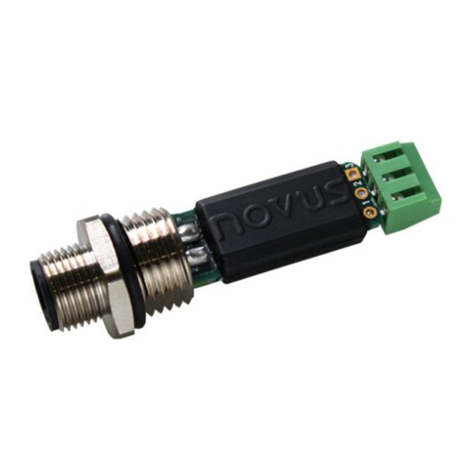
Novus
Novus TXMINI-M12-485 User manual

Novus
Novus TL400-V User manual
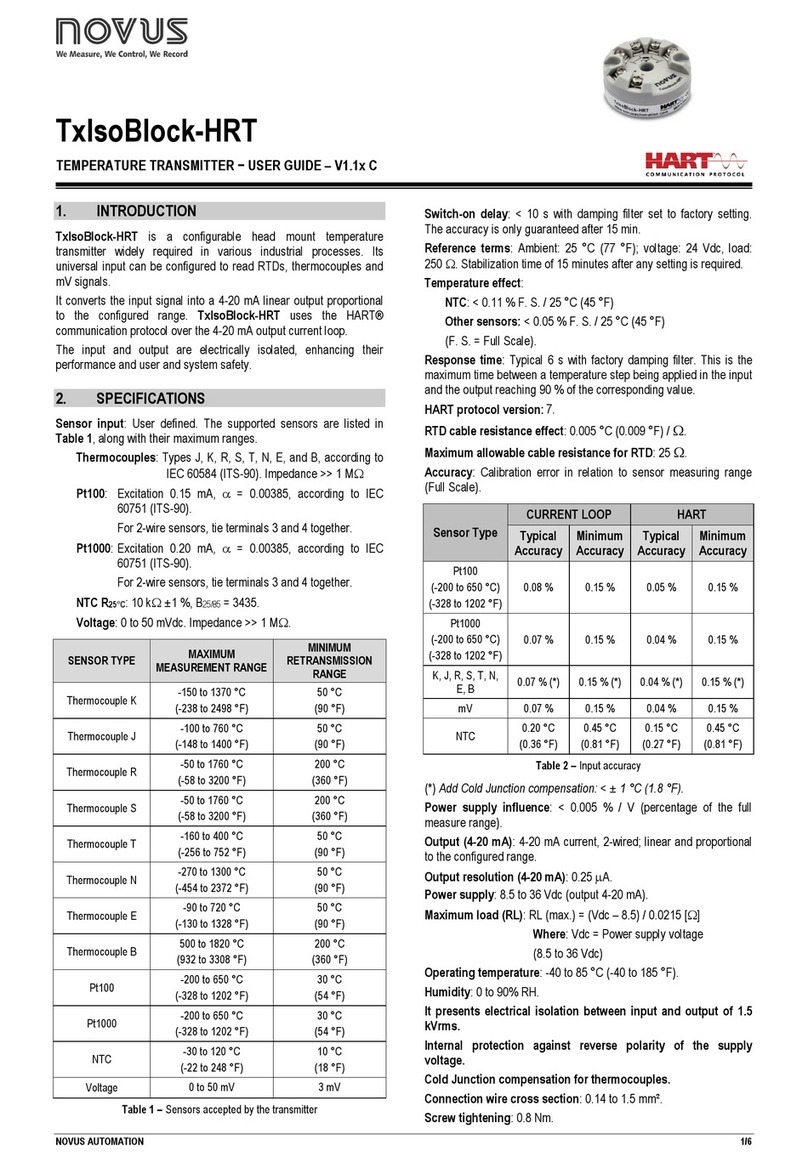
Novus
Novus TxIsoBlock-HRT User manual
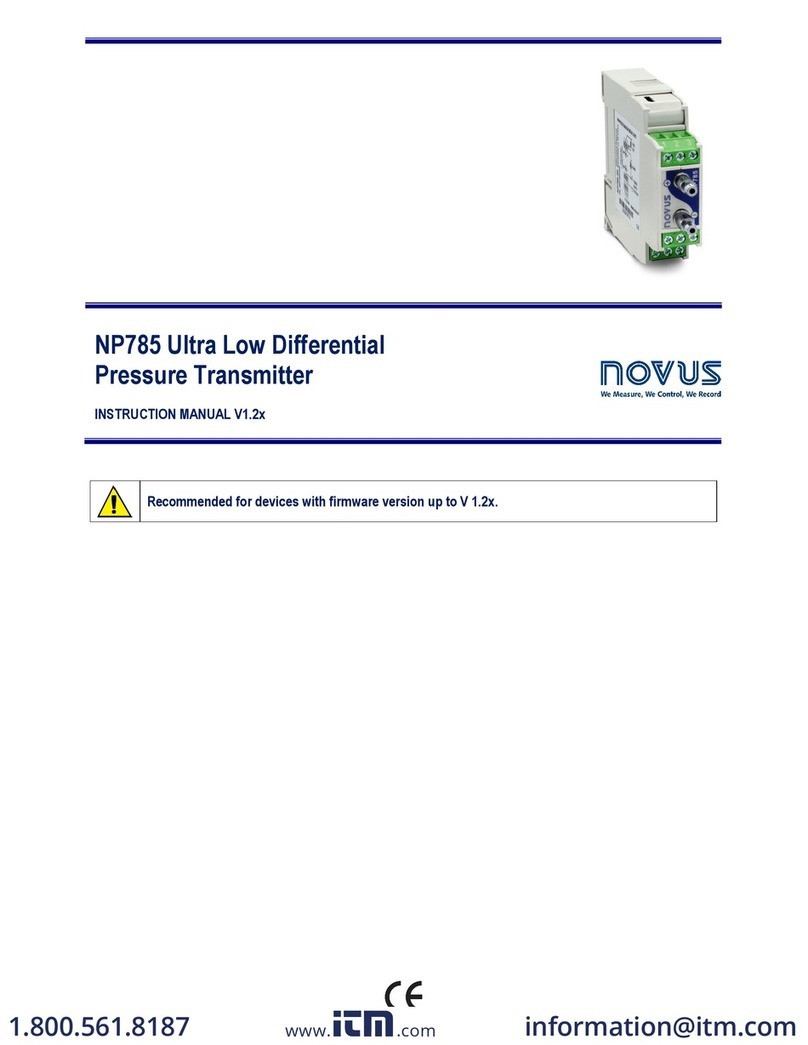
Novus
Novus NP785 User manual
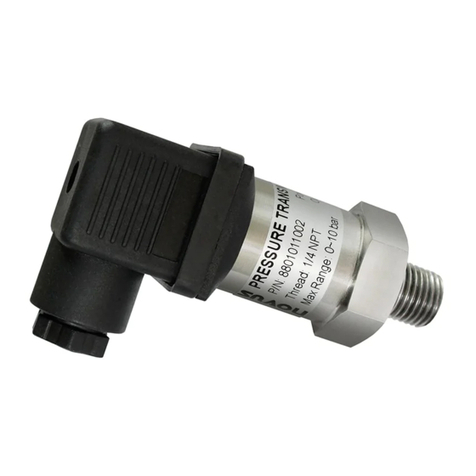
Novus
Novus NP640 User manual
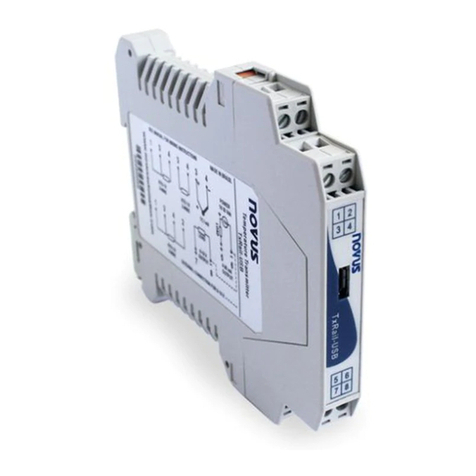
Novus
Novus TxRail-USB User manual
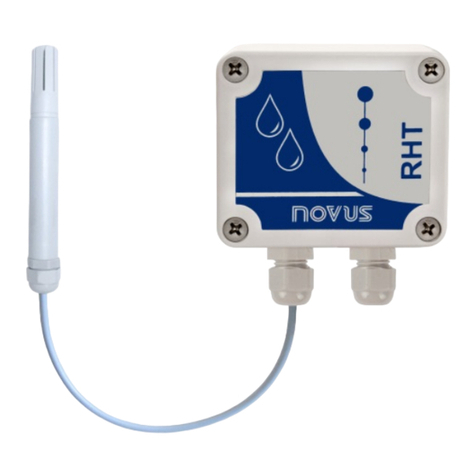
Novus
Novus RHT-XS User manual
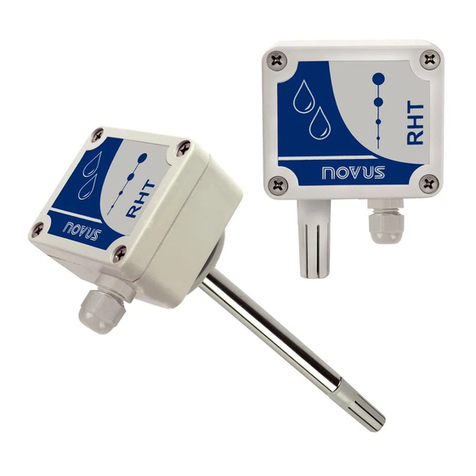
Novus
Novus RHT-WM User manual
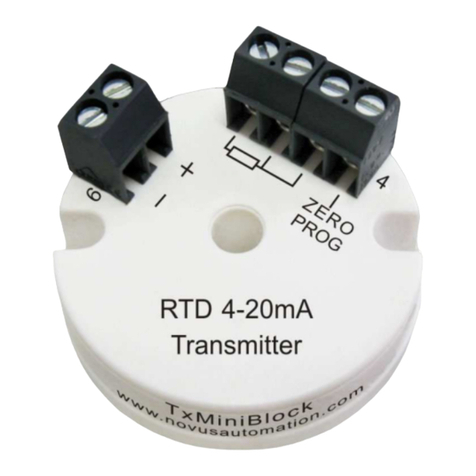
Novus
Novus TxMiniBlock User manual
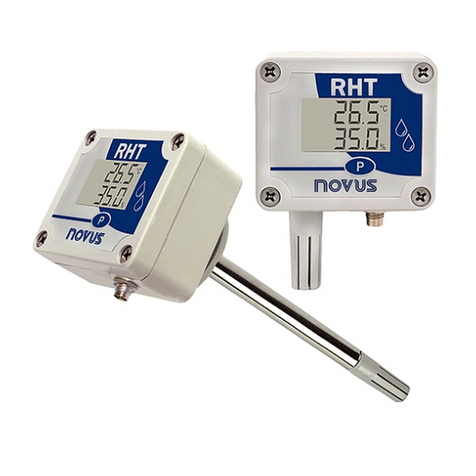
Novus
Novus RHT-WM-485-LCD User manual
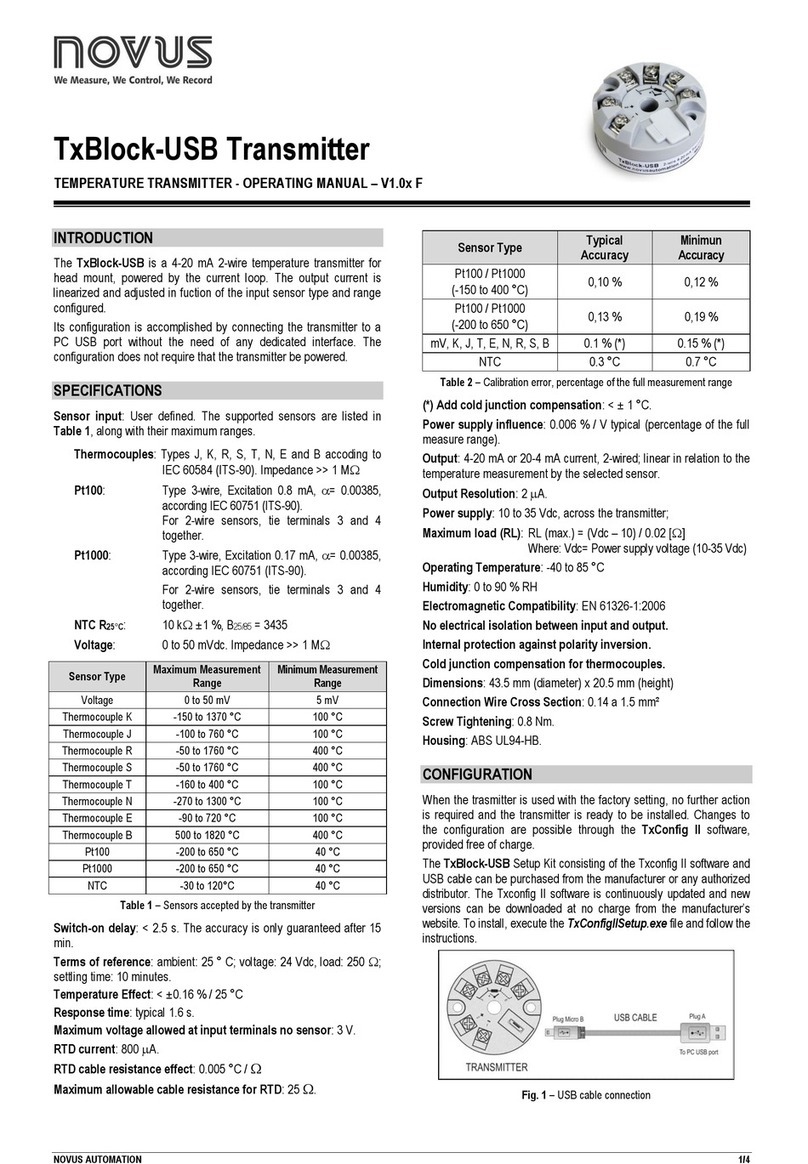
Novus
Novus TxBlock-USB User manual

Novus
Novus NP785 User manual
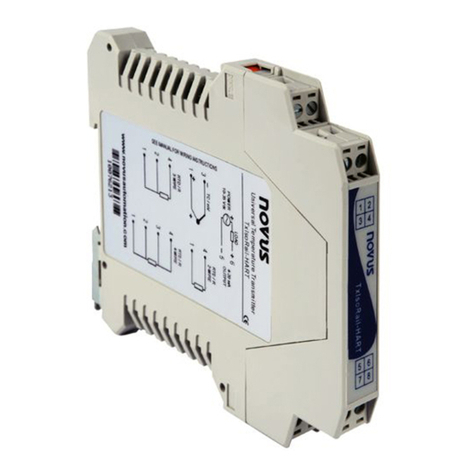
Novus
Novus TxIsoRail-HRT User manual
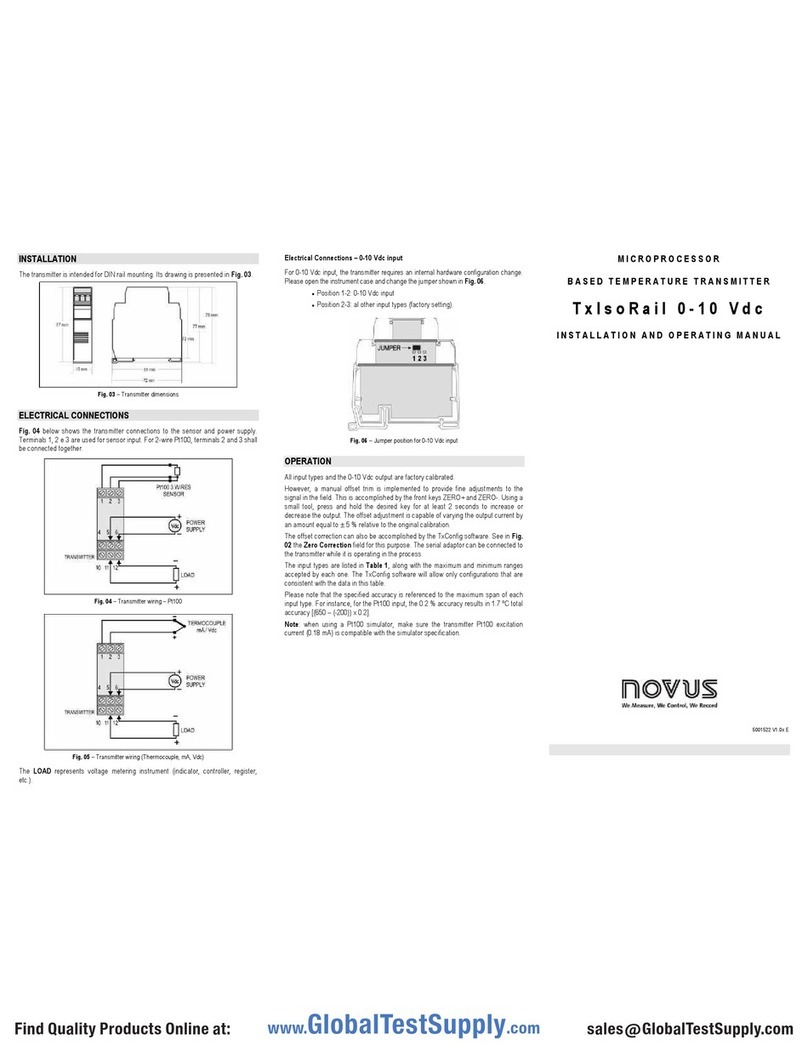
Novus
Novus TxIsoRail0-10Vdc User manual

Novus
Novus TxBlock-USB User manual
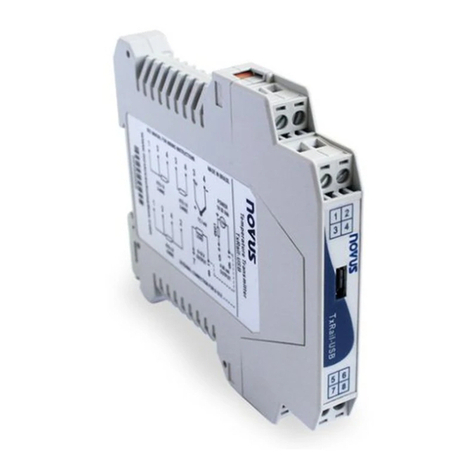
Novus
Novus TxRail User manual
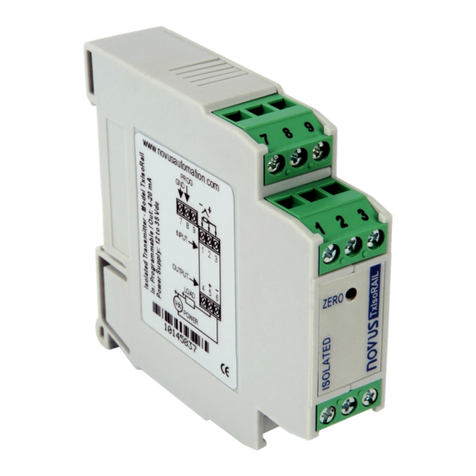
Novus
Novus TxIsoRail User manual

Novus
Novus TxRail User manual
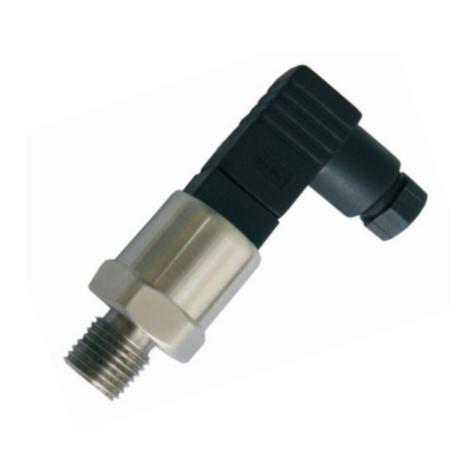
Novus
Novus NP-430D User manual
